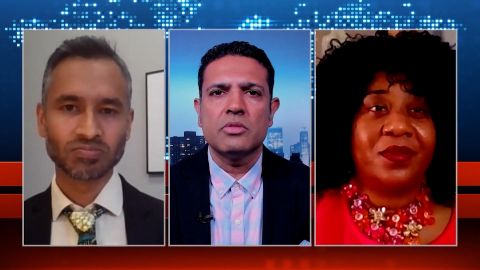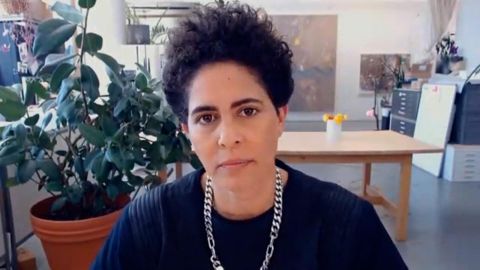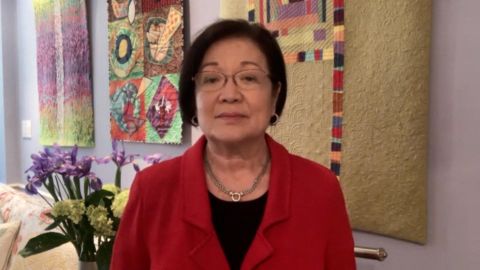Read Transcript EXPAND
CHRISTIANE AMANPOUR: Now, as President Biden tries to take the global lead on combating climate change, he’s also focused on the local level, pledging to invest in minority communities who too often bear the brunt of environmental degradation. Vivek Maru is founder of the Namati which empowers grassroots groups to protect common lands and enforce environmental laws. And Rhonda Hamilton works with Namati to combat unlawful pollution in her own D.C. neighborhood. And here they are in conversation with Hari Sreenivasan.
HARI SREENIVASAN: Christiane, thanks. Vivek Maru, Rhonda Hamilton, thanks for joining us. But, Vic, I want to start with you. So, what does environmental justice look like on a local level like what Rhonda is doing or a global level like the places that Namati works?
VIVEK MARU, FOUNDER AND CEO, NAMATI: Environmental justice, it’s simple, it means you shouldn’t have to choose between having a job and being poisoned. Environmental justice means democratizing decision making so that ordinary people can make a decision about whether a facility is going to be built in their neighborhood or not, what the terms are going to be if it is going to get built and how those terms are going to be enforced. And if I just zoom a little bit and I think this applies both at home in abroad, environmental justice means recognizing our fundamental interdependence and building relationships that are respectful and harmonious with the natural world and with each other.
SREENIVASAN: Rhonda, for people who are not familiar with the section of D.C. that you live in, tell us a little bit about the challenges that you’re facing, what your community is living through and just give us — paint us a picture, if you will, if I looked out your window and walk down your block, what am I likely to see around where people live?
RHONDA HAMILTON, LEGAL EMPOWERMENT ADVOCATE, NAMATI: Our community (INAUDIBLE) shadow of the nation’s capital to, where the homes of old D.C. or not (INAUDIBLE) as well as national ball park. We live right beside an industrial ground field area that is referred to as the (INAUDIBLE) point. That area right not is in the process of going through a major redevelopment process. There are two active cement projects, two active cement industries with (INAUDIBLE) facility that release toxic dust to our community. There are two Pepco (ph) substations that release radiation around the clock. In addition to that, the District of Columbia is reconstructing the Frederick Douglass Memorial Bridge and that project is going — is being developed and on the side of this point, it’s releasing so many toxic chemicals to our community and both stadiums were constructed over ground field sites. So, every day, we’re exposed to contaminated air with particulate matter, all you see if dust, debris and you breathe in constant diesel fumes on so many cement trucks going in and out of these facilities.
SREENIVASAN: So, Rhonda, give me an idea for someone watching who doesn’t know your community, what are the health consequences of these environmental conditions that you’re describing here, either for yourself, for your family or your neighbors, what do you notice in your neighborhood that isn’t the same when you go to fancier part of D.C.?
HAMILTON: We have higher rates of respiratory ailments as asthma. Often times, if you don’t have respiratory issues, you will notice very quickly several months after you lived here, you might develop severe allergies or respiratory conditions. We’ve lost so many neighbors to cancer, heart disease. It’s just been very difficult on the community, and people that were fairly young isn’t — they were in their 40s and 50s. I’ll never forget my neighbor, he went to the doctor and found out he had stage 4 cancer. And I remember he had a dog, a very nice dog. He would go down to (INAUDIBLE) three and four times a day. Let the dog run around. He said it would give him room to play and enjoy himself. And he got sick and he died from cancer. And I feel like that area with all of its toxins, these are chemicals that are being unearthed. Once they enter your body, they damage your respiratory systems and your vital organs. These are chemicals that 5, 10, 15 years down the line, you — my community will continue to be impacted and we will continue to lose people to these diseases because we’re all breathing in this contaminated dust and air with high raise (ph) of particular matter from these facilities.
SREENIVASAN: Vivek, if you could draw kind of a dotted line or a dash line or a solid line between environmental injustice and discrimination of other source or structural racism as it might exist.
MARU: Yes. Absolutely. This is a global phenomenon. People who have less wealth, less power, people who face discrimination are more likely to be dump on without their consent. They are more likely to be experiencing the brunt, as Rhonda said, of environmental harms. My whole family, Hari, comes from Kutch, which is a district on the western coast of India. And in the last 30 years, the fact that Kutch is poor, the fact that it is remote, those things have been used as an excuse to turn it into a sacrifice zone. Today, two of the biggest coal plants on the planet, 4,500 megawatts each are across the street from each other in a little town in Southern Kutch. And those two coal plants are surrounded by an industrial zone with over 100 factories, many of which are flagrantly violating environmental regulation. There are parts in Kutch, Hari, where there’s almost no water left in the ground, where it hurts to breathe. And if I come to Sierra Leone, another example in West Africa, we work with communities there who woke up one morning to find that all the land they’d ever known was signed away to an oil pump plantation, over 100,000 acres of forest land without their consent. And then just bringing back to United States, African-Americans in the United States are 75 percent more likely than the general population to live next door to a facility that uses hazardous chemicals. Black people experienced one and a half times the burden of particulate matter pollution compared to the general population. And it’s disparities like those that are part of why black people, brown people, indigenous people are dying disproportionately from the from the coronavirus. So, indeed, the way the environmental harm is distributed in the world, it’s tightly connected to these other underlying inequalities.
SREENIVASAN: Rhonda, Vivek just mentioned this idea of sacrificed people. You feel like Buzzard Point is the payment for what the rest of D.C. gets to enjoy?
HAMILTON: I feel like Buzzard Point is one of most of the (INAUDIBLE) in the city that are absolving the impact of these environmental homes from toxic chemicals that have been purposely placed out in times, it’s been generations before our — us even coming into the community. I feel like it’s a consequence for the redevelopment, for meeting facilities, to build buildings for not being willing to clean up sites like Buzzard Point 100 percent before you redevelop. The coexist toxic industrial facilities and built residence across the street from them. They’re just equally as impacted as we have been for so many generations. All of us are grown up and have grown up being exposed to these toxic chemicals. So, I feel like it’s definitely a direct consequence of this rush for redevelopment and this rush to build an increased population but without looking very deeply at these — what’s rooted in these environmental injustices and correcting them before we move forward to continue to add onto these areas like Buzzard Point and a number of other areas in the city.
SREENIVASAN: So, Rhonda, tell me what were you able to do? Where do you start? Taking on a situation like this, who do you start to approach? Do you go to the companies first? Do you go to your local government first? How do you find the data if you think someone is a bad actor?
HAMILTON: Well, as we initially (INAUDIBLE) leaders to tell our stories and to let them know how we have been negatively impacted by these environmental hazards, we began telling our story, the Buzzard Point story, to so many people and different organizations trying to get help. Because oftentimes communities like mine, we are very limited with resources because in addition to that, oftentimes we do not have the computer access. That’s why efforts such as working with Namati has been so important because they meet the community to where they are. They come into our — the heart of our community and help us. So, through our advocacy and by reaching out to get help, that’s how we’ve been able to obtain support throughout this process.
SREENIVASAN: Vivek, as have this conversation, there is a lot of focus on literally the 40,000-foot, 50,000-foot, the greenhouse gas emissions. Vivek, kind of take that — bring that back down to earth for us. What are the costs on the ground to the communities who actually feel a disproportionate impact of this climate emergency on their lives?
MARU: Absolutely. Yes. It can seem abstract to people, I think. But if you are living on the front lines of this destruction, it is not abstract at all. It’s people like those indigenous leaders in Amazon who are living — who are losing the forest that they depend, it’s people like Rhonda and her community that are breathing air that is making them sick. And that’s on the things that are creating the climate crisis, those things are polluting people right where they are, whether it’s coal plants or deforestation, oil pump plantations, new fossil fuel infrastructure, they are hurting people’s water, air, land in the present day. And so, the struggles against those things are crucial. And then if you take the other side of the equation, which is the changes that are happening to the climate, those are those are hurting, oftentimes, the very same people in very material and concrete ways. It’s not abstract at all. I mentioned the indigenous communities who are — who steward those grazing lands in Kenya, those are some of the lands most affected by climate change in the whole world. The drought patterns are changing, the amount of water in the ground is changing. And so, it’s crucial that they have greater power in order to build that resilience so that we can adapt and move forward.
SREENIVASAN: Rhonda, what kind of resistance have you faced when trying to get justice for your community?
HAMILTON: We face such tremendous amount of resistance. Initially, we thought that this would be easy and a no-brainer situation and people would see the harm that we’re going through and say, we’re working on it, it would just be automatically corrected. We’re going fix these problems. We’re going to remove these facilities. We’re going to close them down. We’re going to make sure that you all live in quality environment. That has not been the case. Our interest in our health (INAUDIBLE) to take a backseat to the redevelopment of this area. We are up against multimillion dollar projects. Oftentimes, these specific facilities have the upper hand and that their rights are the priority and not ours. It’s as if our lands are being sacrificed to redevelop this area by any means necessary.
SREENIVASAN: Vivek, what are some of the personal harms and risks that advocates are taking upon themselves around the world that you’re working with right now? I know, as we’re talking, there’s a new international agreement going into effect that’s been signed by lots of South American, Central American and Caribbean countries. Tell us a little bit about that and why that’s important as well.
MARU: Yes. This is a shameful fact, Hari, about the century that we live in, which is that standing up for the planet can get you killed. In the Peruvian Amazon, in just a three-week period at the end of February and early March, three indigenous leaders who were involved in resisting unlawful deforestation in Amazon were murdered, Herasmo Grau, Yenes Bonsano, Estela Mauricio. And when these people stand up to protect themselves, they are protecting all of us. And yet, instead of offering them protection, we are allowing them to be killed. And it’s not just the three of them, Global Witness documents publicly reported killings of environment defenders every year. The last data they have out was to from 2019, over 220 killings, and that was the highest since they began tracking about 10 years earlier. And so, we ought to be affording these folks the kinds of protections that we give, say, witnesses in criminal cases or corporate whistleblowers. In this Escazu Agreement that you’ve mentioned is crucial because it’s the first agreement to actually insist that member nations create protections for environmental defenders. And more broadly, it aims to democratize environmental governance, to give people who depend on lands more of a say in what happens to those lands, whether or not something should get built in their neighborhood. If so, on what terms and how those terms are going to be enforced. And I would say, you know, President Biden, to his credit, he has prioritized environmental justice at home. But global environmental policy continues to be largely technocratic and top down focused on emissions reductions, investments in technology, which are essential things. We need those urgently. But by themselves, they are insufficient. And so, I think one of the opportunities that the Biden administration has is to bring that attention to environmental justice that his applied at home to its approach to global environmental policy. I would suggest that we negotiate towards a global version of the Escazu Agreement, a kind of part 2 of the Paris Agreement because we are ultimately not going to find our way out of this grave environmental crisis unless we grapple with the underlying inequalities that have made the destruction possible.
SREENIVASAN: What are steps of the Biden administration can be taking in terms of existing policy priorities or proposals that they’re already pushing which could also help alleviate some of the environmental injustices that you’re talking about?
MARU: Yes. I do think that the Biden administration deserves credit for taking environmental justice more seriously than any other administration in U.S. history. In fact, one of the things that they’ve done that’s really important is that they’ve reached out to people who are most affected, Rhonda is among those who’ve been part of conversations about what a way forward looks like. And specifically, this Infrastructure Bill that is being debated in Congress right now, it has a really important principle in it which is Justice 40, meaning that 40 percent of the investments will go to communities that have been historically disadvantaged. So, I think that’s going to be a crucial step. I think we need to do much more than that. And there’s something called the THRIVE Act, which is going to be introduced in Congress soon which is bigger and bolder and gets closer to what I think the science and the inequality crisis both require of us.
SREENIVASAN: Rhonda, what have you been able to accomplish so far in your community and beyond that, what does environmental justice look like to you for the people you live with?
HAMILTON: So far, we’ve been able to accomplish, we have air quality monitor that’s been put up, it’s been about three years at (INAUDIBLE) Correct Center. It gives our air policy readings. So, we know the quality of the air that we’re breathing. In additional to that, there was a fence installed around the South Capitol Street Bridge project. It was a clean field site. There were mounds of dust that was being stored. We were very concerned about our children falling into one of their mounds. We were able to reach out to the bridge teams to do a walk through with them, their resources and a fence being put over around that site to protect the community. These might sound like small victories, but to us, it means a great deal. This has really reached — it’s been just a tremendous experience to be able to receive the help and support, to help my community. At one point, it was like we had lost hope. It has been an uphill battle. But these small victories give us hope and help us to know that someone is listening and someone cares and they’re being responsive to some of the concerns.
SREENIVASAN: Vivek Maru, Rhonda Hamilton, thank you both.
MARU: Thank you, Hari. Great to be here.
About This Episode EXPAND
Mazie Hirono; Julie Mehretu; Vivek Maru and Rhonda Hamilton
LEARN MORE


